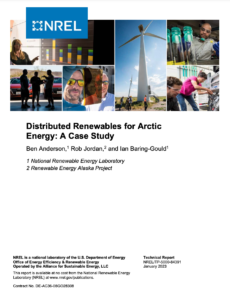Full Title: Distributed Renewables for Arctic Energy: A Case Study
Author(s): Ben Anderson, Rob Jordan, and Ian Baring-Gould
Publisher(s): National Renewable Energy Laboratory
Publication Date: January 20, 2023
Full Text: Download Resource
Description (excerpt):
Alaska is a vast state that stretches into the Arctic Circle. Roughly 140,000 people in the state depend on isolated electric grids, traditionally burning expensive fossil fuels. These fuel sources have negative impacts on air quality and climate. As the climate warms, fuel supply chains and traditional ways of life are threatened. Renewable energy systems offer a clean, resilient alternative with less volatile costs to remote Arctic communities, but developing them raises a variety of technical, social, economic, and political challenges. Examples include harsh operating conditions, lack of local technical and managerial capacity, complex funding mechanisms, and lengthy permitting processes.
With many isolated energy systems incorporating a variety of renewable technologies, Alaskan communities provide valuable lessons that can be applied across the Arctic. In this case study, we interviewed communities that are interested in adding renewables to their energy systems to understand their needs and challenges. We also interviewed communities that have successfully installed renewable energy to understand how they overcame such challenges and the lessons they learned. Notable results include the importance of local buy-in, education, and technical involvement; procuring external funding sources; inter-community collaboration; installing bespoke systems; working with reliable equipment suppliers; and having a local “project
champion”. The goal of this report is to orient and inspire Arctic communities that want to begin their renewable energy transition, by providing helpful examples and points of contact.
